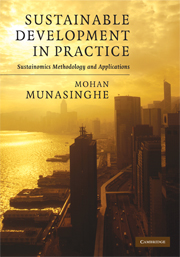Book contents
- Frontmatter
- Contents
- Foreword by James Gustave Speth
- Preface
- Part I Framework and fundamentals
- Part II Global and transnational applications
- 5 Global analytical applications
- 6 International process applications: multilevel, multistakeholder, transdisciplinary dialogues
- Part III National and macroeconomic applications
- Part IV Sub-national sectoral and system applications
- Part V Project and local applications
- References
- Index
5 - Global analytical applications
Published online by Cambridge University Press: 05 August 2012
- Frontmatter
- Contents
- Foreword by James Gustave Speth
- Preface
- Part I Framework and fundamentals
- Part II Global and transnational applications
- 5 Global analytical applications
- 6 International process applications: multilevel, multistakeholder, transdisciplinary dialogues
- Part III National and macroeconomic applications
- Part IV Sub-national sectoral and system applications
- Part V Project and local applications
- References
- Index
Summary
In this chapter, applications of key elements of the sustainomics framework are illustrated through several examples dealing with two critical global problems – climate change and sustainable development, and how they are best addressed together. Section 5.1 provides a general analysis of the circular linkages between these two issues. In Section 5.2, challenges posed to the social, economic and environmental dimensions of sustainable development, and relevant principles for formulating a policy response, are described. Ethical and equity considerations play an important role, especially in addressing the unfair and disproportionately large share of the burden imposed on the poor and vulnerable. Section 5.3 defines and analyses the principal potential human responses – adaptation and mitigation. Several practical applications are provided. Three international-level case studies are described in Section 5.4. First, alternative climate-change-mitigation response strategies are assessed in terms of the optimality and durability approaches. Next, we examine the interplay of equity and efficiency in joint implementation, as well as in emissions trading, especially between Annex 1 and non-Annex 1 countries. Sections 5.5 and 5.6 discuss how a global problem such as climate change might interact with sustainable development at the national level through a case study that examines greenhouse gas (GHG) mitigation prospects in Sri Lanka. National energy-sector responses are analysed, and a real options framework for carbon options trading under uncertainty is described.
- Type
- Chapter
- Information
- Sustainable Development in PracticeSustainomics Methodology and Applications, pp. 137 - 179Publisher: Cambridge University PressPrint publication year: 2009



